In your music theory exam, you will need to know something about the standard orchestral instruments used today. You’ll need to memorise some information about:
- the instrument families,
- the highest and lowest members of each family,
- the clefs each instrument normally uses, and
- whether or not the instrument is a transposing instrument.
The Orchestral Families
In a modern symphony orchestra, there are four families of instruments. The families are:
- Woodwind
- Brass
- Strings
- Percussion
In the following lists, the instruments in each family are written in pitch order, with the highest first (except for the percussion section). You can find out about the normal playing ranges of each instrument here.
Woodwind
In the woodwind family, there are four main instruments:
- Flute

- Oboe

- Clarinet

- Bassoon

Brass
In the brass family, there are four main instruments:
- Trumpet
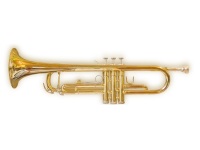
- French Horn
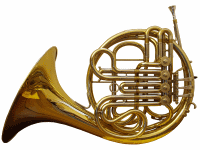
- Trombone
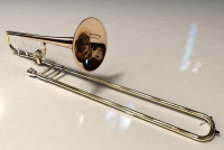
- Tuba
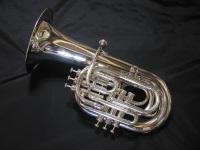
In fact, the French horn has a very big range which overlaps the trumpet and the trombone.
Strings
In the strings family, there are four main instruments: (pictures are not to scale!)
- Violin

- Viola

- Violoncello (‘cello)

- Double bass
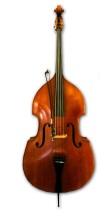
Percussion
In the percussion family there are no “main” instruments, and many of them do not make notes of a “definite pitch”, which means they make “sounds” rather than “notes”. “Definite pitch” instruments make notes which you can write on stave in the normal way. Some instruments which are often used, are (in no particular order):
- Timpani (pitched)

- Marimba and Xylophone (pitched)

- Snare drum (unpitched)
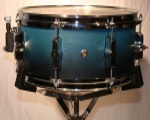
- Cymbals (unpitched)

Of these, the one which most often appears in the ABRSM grade 4 exam is the timpani. Timpani are also called “kettle drums”. A kettle drum is tuned to play a single note. It’s difficult to play a melody on timps because you need a separate drum for each note.
Clefs
The following instruments use the treble clef:
- Flute, oboe, clarinet
- Violin
- Trumpet, French horn
These instruments use the bass clef:
- Bassoon
- Cello, double bass
- Trombone, tuba
- Timpani
The viola uses the alto clef.
Transposing Instruments
Some instruments produce a different note to the one which is read. On the trumpet, for example, if you read/play the note C, the note which is produced is actually a Bb.
In practice, this means that a flute and trumpet could NOT read/play the same line of music together because all the trumpet’s notes would be one tone lower than the flute’s.
We say that a trumpet is “in Bb”, because that’s the note we hear when a trumpeter plays a C. The trumpet is a “transposing instrument”.
The following are NOT transposing instruments:
- Flute, oboe, bassoon
- Trombone, tuba
- Violin, viola, cello
- Timpani
The following are transposing instruments:
- Clarinet, trumpet (Bb)
- French horn (F)
- Double bass (8ve down)
Reading and Playing at the Same Pitch
The following groups of instruments are able to play each other’s music without any change of pitch. This is a very common question in the ABRSM grade 4 (and 5) music theory exams, so it’s worth learning!
- Flute, oboe, violin (treble clef, non-transposing)
- Bassoon, cello, trombone, tuba (bass clef, non-transposing)
- Trumpet, clarinet (treble clef, transposing Bb)
The following instruments cannot play from any other instrument’s music part:
- Timpani (can only play single notes)
- Viola (the only instrument which normally uses the alto clef)
- French horn (the only standard orchestral instrument pitched in F)
- Double bass (the only standard orchestral instrument which sounds an octave lower than written)
There are lots of other instruments of course, but these are the only ones you need to know about in your grade 4 exam!
Some of the instruments named above use more than one clef. For example, the cello uses the bass, tenor and treble clefs. The clefs named above are the “standard” clefs used by each instrument.
Instruments Quiz
10 questions on instruments – refresh the page for a different selection of questions! Pass mark 7/10.
mage credits:
Flute: “Flauto Traverso COMET3” by Loppa – Own work. Licensed under CC BY-SA 3.0 via Wikimedia Commons – http://commons.wikimedia.org/wiki/File:Flauto_Traverso_COMET3.jpg#mediaviewer/File:Flauto_Traverso_COMET3.jpg
Clarinet: “Clarinet” by Ratigan at fr.wikipedia, and it was the same file as Mezzofortist uploaded here. Later versions were uploaded by Luna04, Iunity at fr.wikipedia. This is a cropped version of Iunity’s version. – [1] ; uploaded on fr.wikipedia; description page is/was here.. Licensed under Copyrighted free use via Wikimedia Commons – http://commons.wikimedia.org/wiki/File:Clarinet.jpg#mediaviewer/File:Clarinet.jpg
Oboe: “Hobo”. Licensed under CC BY-SA 3.0 via Wikimedia Commons – http://commons.wikimedia.org/wiki/File:Hobo.jpg#mediaviewer/File:Hobo.jpg
Bassoon: “FoxBassoon” by Gregory F. Maxwell <http://commons.wikimedia.org/wiki/File:FoxBassoon.jpg#mediaviewer/File:FoxBassoon.jpg
Violin: “Old violin” by Frinck51 – Photo by Frinck51. Licensed under CC BY-SA 3.0 via Wikimedia Commons – http://commons.wikimedia.org/wiki/File:Old_violin.jpg#mediaviewer/File:Old_violin.jpg
Viola: “Bratsche” by Just plain Bill – Own work. Licensed under Public Domain via Wikimedia Commons – http://commons.wikimedia.org/wiki/File:Bratsche.jpg#mediaviewer/File:Bratsche.jpg
Cello: “Cello front side” by Georg Feitscher – Own work. Licensed under CC BY-SA 3.0 via Wikimedia Commons – http://commons.wikimedia.org/wiki/File:Cello_front_side.jpg#mediaviewer/File:Cello_front_side.jpg
Double bass: “AGK bass1 full” by User:AndrewKepert – User:AndrewKepert created this and uploaded this to the English Wikipedia.. Licenced under CC BY-SA 3.0 via Wikimedia Commons – http://commons.wikimedia.org/wiki/File:AGK_bass1_full.jpg#mediaviewer/File:AGK_bass1_full.jpg
Trumpet: “Trumpet 1”. Licensed under CC BY-SA 3.0 via Wikimedia Commons – http://commons.wikimedia.org/wiki/File:Trumpet_1.jpg#mediaviewer/File:Trumpet_1.jpg
French horn: “French horn front”. Licensed under CC BY 2.5 via Wikimedia Commons – http://commons.wikimedia.org/wiki/File:French_horn_front.png#mediaviewer/File:French_horn_front.png
Trombone: “Trombone CG Bach42AG” by FlamM at the French language Wikipedia. Licensed under CC BY-SA 3.0 via Wikimedia Commons – http://commons.wikimedia.org/wiki/File:Trombone_CG_Bach42AG.jpg#mediaviewer/File:Trombone_CG_Bach42AG.jpg
Tuba: “Frenchtuba” by Hidekazu Okayama – PROJECT EUPHONIUM (Hidekazu Okayama). Licensed under CC BY-SA 3.0 via Wikimedia Commons – http://commons.wikimedia.org/wiki/File:Frenchtuba.jpg#mediaviewer/File:Frenchtuba.jpg
Timpani: “Berliner Pauken” by Lefima GmbH – Lefima GmbH. Licensed under CC BY-SA 3.0 via Wikimedia Commons – http://commons.wikimedia.org/wiki/File:Berliner_Pauken.jpg#mediaviewer/File:Berliner_Pauken.jpg
Marimba: “Marimba One 4000 Series” by Marimbaone – Own work. Licensed under CC BY-SA 3.0 via Wikimedia Commons – http://commons.wikimedia.org/wiki/File:Marimba_One_4000_Series.jpg#mediaviewer/File:Marimba_One_4000_Series.jpg
Snare drum: “2006-07-06 snare 14” by Stephan Czuratis (Jazz-face) – Own work. Licensed under CC BY-SA 2.5 via Wikimedia Commons – http://commons.wikimedia.org/wiki/File:2006-07-06_snare_14.jpg#mediaviewer/File:2006-07-06_snare_14.jpg
Cymbal: “2006-07-06 Crash Zildjian 14” by Stephan Czuratis (Jazz-face) – Own work. Licensed under CC BY-SA 2.5 via Wikimedia Commons – http://commons.wikimedia.org/wiki/File:2006-07-06_Crash_Zildjian_14.jpg#mediaviewer/File:2006-07-06_Crash_Zildjian_14.jpg